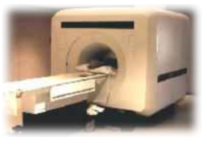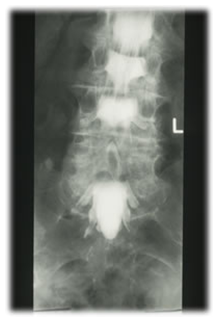X-rays - CAT Scan, CT or Computerised Tomography - Magnetic Resonance Imaging (MRI) - Myelogram - EMG or Electro-Myelogram - Discogram or Discography
The Initial Interview
A complete history can help to determine the type and seriousness of a spinal condition. This is followed by a thorough physical examination of your spine. Examination of neurological function, which includes assessment of strength and sensation in the arms and/or legs can determine whether any spinal nerves are involved and the extent of any deficit. Questionnaires of disability assist in the assessment of difficulty in performing daily tasks and can be used for comparison over a period of time to track the progress of a condition or response to treatment.
X-Rays
These may help to identify a major abnormality of spinal anatomy. This may include signs of arthritis, a fracture or slippage of a vertebra. Flexion and extension x-rays give further information about abnormal spinal motion when a person bends. Overall the ability of plain x-rays to show the cause of conditions such as back pain is limited. One reason for this is that the "abnormalities" shown on plain x-ray are very common, even amongst individuals who have no pain.
CAT Scan, CT or Computerised Tomography
This is a special type of x-ray study where images are cross-sections of the spine. Modern scanning is now able to reassemble the individual cross-section and to make a series of computerised images in any direction, not only cross section. Even 3-dimensional images may be produced to provide the maximum available detail. These pictures help to identify spinal abnormalities, most particularly of bone. This study is also useful for evaluating spinal nerves and fractures.
Magnetic Resonance Imaging (MRI)

This is a very powerful technique for demonstrating the soft tissue of the spine (e.g. discs, nerves). The pictures are so complete that many of the signals which were initially thought to be abnormal were later found to occur in a large proportion of the general population and so may actually be a "normal" part of the ageing process. As shown the scanner is quite confining and a routine scan takes about 20 minutes. About 10% of people suffer claustrophobia which is severe enough to require sedation when having the scan. Scanning may also be quite noisy and music is provided through headphones. An MRI is often taken to confirm a disc herniation. Patients who have heart pacemakers or foreign material in their eyes are unable to have MRI scans.
Myelogram

A special x-ray test used to detect narrowing of the spinal canal with compression of spinal cord or nerve roots. A radiologist performs the procedure and an overnight stay in the hospital is required. A special dye is injected into the spinal canal and fills the available space. Where narrowing occurs or a nerve is compressed the dye fails to fill the region. A myelogram may be required when spinal stenosis is suspected but where a patient has a significant spinal curvature which would make interpretation of an MRI scan difficult or when a patient has a pacemaker. Usually a CAT scan is also performed while the dye is still in place. A myelogram of the neck may be required where nerve compression is suspected as this is often a difficult area to image with MRI.
EMG or Electro-Myelogram
This test is used to identify problems with the nerves which go to the extremities. A sterile needle electrode is inserted into the muscle being tested. An EMG can determine abnormalities with the nerves and where the problem is located, i.e. the spine or extremities. Nerve problems can originate from your spine, a medical condition (such as diabetes) or a combination of both.
EMG's are performed by a neurologist.
Discogram or Discography
This allows for specific evaluation of one or more of the discs of the spine. A special dye is injected into the discs, along with saline and an antibiotic. Information about the discs structure and its relationship to back and/or leg pain symptoms is obtained. The study is often recommended for patients who may require fusion surgery.
